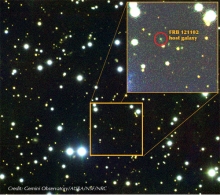How do stars form in distant galaxies? Astronomers have long been trying to answer this question by detecting radio signals emitted by nearby galaxies. However, these signals become weaker the further away a galaxy is from Earth, making it difficult for current radio telescopes to pick up.

Category:
Published on: 16 Jan 2023

Astronomers have pinpointed for the first time the home galaxy of a Fast Radio Burst, moving scientists a step closer to detecting what causes these powerful but fleeting pulses of radio waves. FRBs, which last just a few thousandths of a second, have puzzled astrophysicists since their discovery a decade ago.
Category:
Published on: 4 Jan 2017

Astronomers have found a galaxy turning gas into stars with almost 100 percent efficiency, a rare phase of galaxy evolution that is the most extreme yet observed. The findings come from the IRAM Plateau de Bure interferometer in the French Alps, NASA's Wide-field Infrared Survey Explorer and NASA's Hubble Space Telescope.
Category:
Published on: 23 Apr 2013
